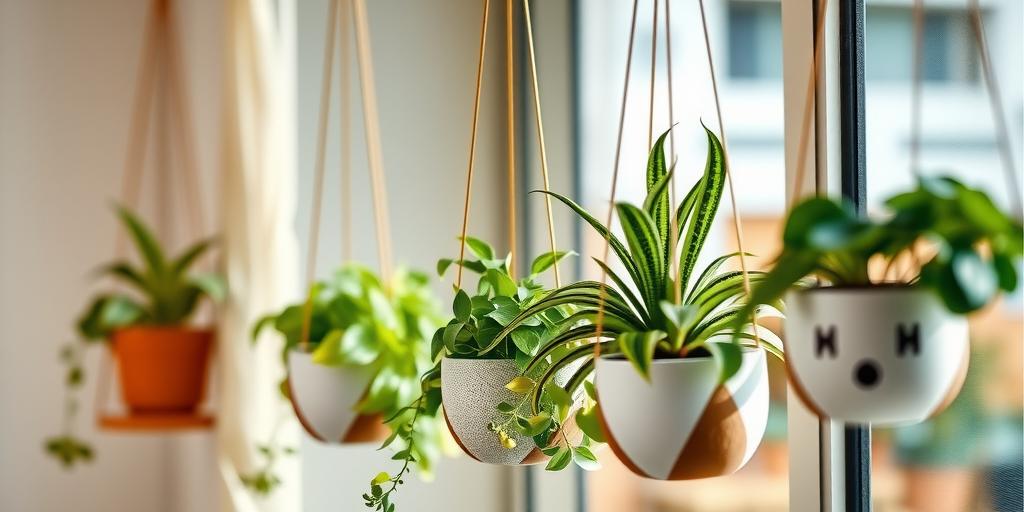
DIY Eco-Friendly Hanging Planters for Low Light Plants: A Sustainable Guide
Discover how to make DIY eco-friendly hanging planters for low light plants! Perfect for small spaces, these sustainable projects will brighten your home while reducing waste.
Introduction
Did you know that indoor plants can boost your mood by up to 15%? But what if your space lacks natural light? No problem! Low light plants like pothos, snake plants, and ZZ plants thrive in dim corners, and hanging them in eco-friendly planters adds a stylish, sustainable touch. In this guide, we’ll show you how to craft beautiful, planet-friendly hanging planters using recycled materials—perfect for urban jungles and eco-conscious plant lovers!
Why Choose Eco-Friendly Hanging Planters?
Benefits of Sustainable Planters for the Environment
Eco-friendly hanging planters are a fantastic way to reduce your carbon footprint while bringing greenery into your home. Traditional plastic planters contribute to landfill waste and often contain harmful chemicals. By opting for sustainable materials like recycled glass, fabric, or natural fibers, you’re helping to minimize plastic pollution and support a circular economy. Plus, plants themselves improve air quality, making your home healthier.
How Upcycling Reduces Waste and Saves Money
One of the best things about DIY eco-friendly planters is that they often use materials you already have at home. Old glass jars, tin cans, or fabric scraps can be transformed into beautiful planters with just a little creativity. This not only keeps waste out of landfills but also saves you money—no need to buy expensive store-bought planters when you can make your own for free!
Aesthetic Appeal of Handmade Planters in Home Decor
Handmade planters add a unique, personal touch to your space. Whether you opt for a rustic macramé hanger or a sleek upcycled jar, each piece has its own character. Unlike mass-produced planters, DIY projects allow you to customize colors, textures, and sizes to perfectly match your home’s style.
Best Low Light Plants for Hanging Planters
Top 5 Low Light Plants
Not all plants need bright sunlight to thrive. Here are five great options for low light conditions:
-
Pothos – Hardy and fast-growing, with trailing vines perfect for hanging.
-
Spider Plant – Produces baby offshoots that dangle beautifully.
-
Philodendron – Similar to pothos but with heart-shaped leaves.
-
ZZ Plant – Extremely low-maintenance and drought-tolerant.
-
Peperomia – Compact and comes in many unique leaf patterns.
Care Tips for Each Plant
-
Pothos: Water when the top inch of soil is dry; thrives in indirect light.
-
Spider Plant: Keep soil slightly moist; tolerates low light but prefers bright, indirect light.
-
Philodendron: Water when soil feels dry; avoid direct sunlight.
-
ZZ Plant: Water sparingly (every 2-3 weeks); thrives in low to moderate light.
-
Peperomia: Let soil dry between waterings; prefers medium to low light.
Why These Plants Thrive in Hanging Setups
These plants are ideal for hanging because they naturally trail or cascade, creating a lush, flowing effect. They also adapt well to the limited light conditions often found in hanging spots away from windows.
Materials Needed for DIY Eco-Friendly Hanging Planters
Recycled Materials
-
Glass jars (mason jars, pasta sauce jars)
-
Tin cans (cleaned and sanded)
-
Fabric scraps (old t-shirts, burlap)
-
Wooden crates or pallet scraps
Natural Fibers for Macramé Hangers
-
Jute, hemp, or cotton rope (great for knotting)
-
Twine or yarn (for lightweight planters)
Non-Toxic Paints and Sealants
-
Chalk paint or acrylics for decorating
-
Water-based sealant to protect painted surfaces
-
Natural dyes (like beet juice or turmeric) for a chemical-free option
Step-by-Step DIY Hanging Planter Projects
Macramé Hanging Planter (Knot-Free Beginner Version)
-
Cut four equal lengths of jute rope (about 3 feet each).
-
Fold them in half and loop through a wooden ring or metal hoop.
-
Tie a simple overhand knot about 6 inches below the hoop.
-
Separate the strands into pairs and tie another knot a few inches down.
-
Gather all strands and tie one final knot at the bottom to secure.
-
Place a small pot inside the hanger and adjust the knots as needed.
Upcycled Jar or Tin Can Hanger
-
Clean and dry your jar or can thoroughly.
-
Use a drill to make drainage holes in the bottom (if using a can, sand sharp edges).
-
Paint or decorate with non-toxic paint (optional).
-
Wrap wire around the rim to create a hanger, or attach twine loops.
-
Hang and add your plant!
Fabric-Wrapped Hanging Planter (No-Sew Method)
-
Cut a rectangle of fabric (about 12x18 inches).
-
Fold it in half lengthwise and glue the edges, leaving the top open.
-
Once dry, flip inside out to hide seams.
-
Fold the top edge outward to create a cuff, then punch small holes on each side.
-
Thread twine through the holes to create a hanger.
-
Insert a plastic liner (optional) and add your plant.
Tips for Maintaining Hanging Plants in Low Light
How Often to Water Low Light Plants
Since low light plants grow slower, they need less water. Check the soil before watering—stick your finger in about an inch deep. If it’s dry, it’s time to water. Overwatering is a common mistake, so err on the side of underwatering.
Avoiding Root Rot with Proper Drainage
Always ensure your DIY planters have drainage holes. If using glass jars without holes, add a layer of pebbles at the bottom to prevent water from pooling.
Rotating Plants for Even Growth
Low light plants will lean toward any available light. Rotate them every few weeks to keep growth balanced and prevent lopsidedness.
Creative Ways to Display Your Hanging Planters
Grouping Planters for a Lush Vertical Garden
Hang multiple planters at different heights to create a cascading green wall. Mix different plant types for texture variation.
Using Wall Hooks and Ceiling Mounts Effectively
-
Wall hooks: Great for lightweight planters near windows.
-
Ceiling mounts: Use sturdy hooks for heavier planters, ensuring they’re anchored securely.
Matching Planter Styles with Home Decor Themes
-
Boho: Macramé hangers with pothos or spider plants.
-
Minimalist: Sleek glass jars with ZZ plants.
-
Rustic: Tin cans with trailing philodendrons.
By following these tips and projects, you can create a sustainable, stylish indoor jungle that thrives even in low light!
Conclusion
Creating DIY eco-friendly hanging planters for low light plants is a fun, sustainable way to bring greenery into your home. Whether you upcycle jars, try macramé, or repurpose fabric, these projects help reduce waste while beautifying your space. Ready to get started? Pick your favorite method and let your creativity grow—literally!
